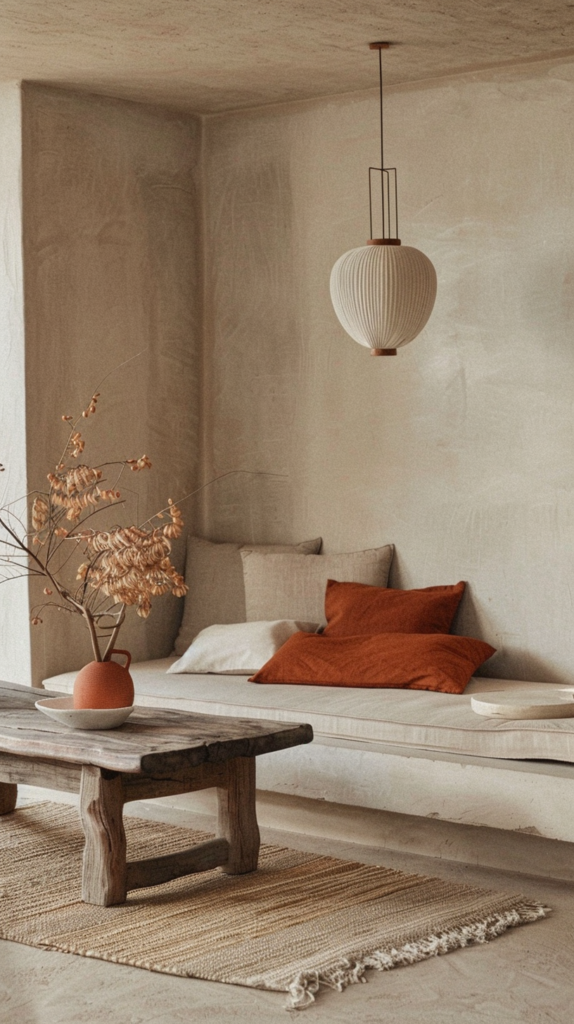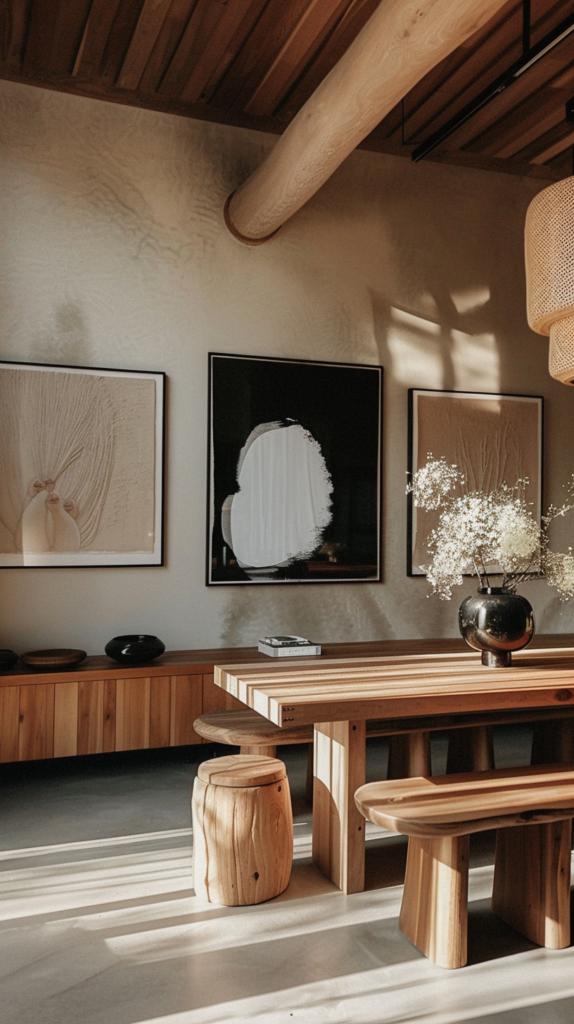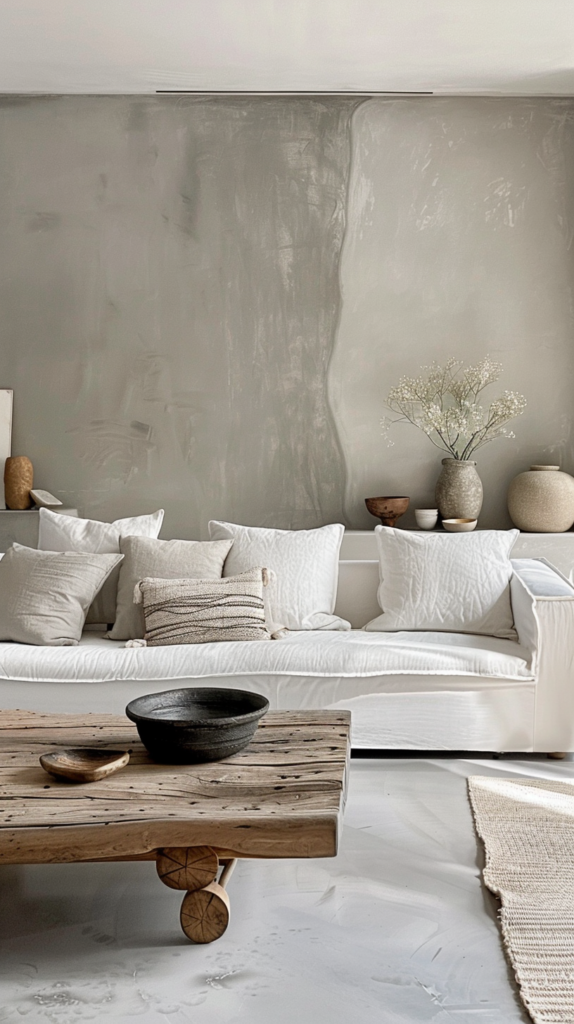Disclosure: Some links on this site are affiliate links. As Amazon Associates, we earn from qualifying purchases (at no cost to you).
Japandi style, a fusion of Japanese minimalism and Scandinavian functionality, has taken the interior design world by storm. This harmonious blend creates spaces that are both serene and inviting.
Let’s explore 10 perfect color choices for your Japandi living room, along with some decor inspiration to bring this style to life.
1. Warm White
Warm white forms the foundation of many Japandi interiors. It creates a clean, bright backdrop that reflects light and makes spaces feel open and airy.

Use warm white on walls and larger furniture pieces. Pair with natural wood tones for a balanced, inviting atmosphere.
2. Soft Gray
A gentle, soft gray adds depth without overwhelming the space. It’s perfect for accent walls or larger furniture items like sofas.

This versatile neutral complements both the cooler tones of Scandinavian design and the warmer hues of Japanese aesthetics.
3. Charcoal
For a bolder statement, incorporate deep charcoal accents. This color adds drama and grounds the space, perfect for smaller decor items or as a contrast wall.

Balance it with lighter neutrals and natural materials to maintain the Japandi harmony.
4. Natural Oak
While not a paint color, the warm tones of natural oak are essential in Japandi design. Incorporate this through furniture, flooring, or decorative elements.

It adds warmth and connects the space to nature, a key principle in both Japanese and Scandinavian design.
5. Sage Green
Sage green brings a touch of nature indoors, creating a calming atmosphere. Use it for accent pieces like cushions, throws, or even a statement chair.

This muted green pairs beautifully with neutral tones and natural wood finishes.
6. Blush Pink
A soft, muted blush pink adds a subtle warmth to Japandi interiors. Use it sparingly in accessories or artwork to create gentle color accents without overpowering the minimalist aesthetic.

7. Navy Blue
Deep navy blue can add a sophisticated touch to your Japandi living room. Use it for smaller furniture pieces or textiles to create depth and interest.

Balance it with lighter neutrals to maintain the overall serenity of the space.
8. Terracotta
Earthy terracotta tones bring warmth and groundedness to Japandi interiors. Incorporate this color through pottery, textiles, or small furniture pieces.

It pairs beautifully with natural woods and adds a subtle pop of color.
9. Beige
A warm beige is another excellent neutral for Japandi spaces. It’s less stark than white but still provides a clean backdrop for other elements.

Use it on walls or larger furniture pieces for a cozy yet minimal feel.
10. Black
Used judiciously, black can add striking contrast in Japandi interiors. Think black picture frames, lamp bases, or thin-framed furniture.

It helps to define spaces and adds a modern edge to the overall design.
Decor Inspiration
When decorating your Japandi living room, remember these key principles:
- Embrace minimalism: Keep decor simple and purposeful.
- Focus on natural materials: Incorporate wood, bamboo, and natural fibers.
- Balance light and dark: Combine lighter neutrals with deeper, grounding tones.
- Add texture: Use textiles and natural materials to create visual interest.
- Incorporate plants: Bring life to the space with carefully chosen greenery.
What Not to Do in Japandi Living Room Design
While embracing Japandi style, it’s important to avoid certain pitfalls:
- Don’t overcrowd the space: Resist the urge to fill every corner. Japandi thrives on negative space and a clutter-free environment.
- Avoid bright, bold colors: Steer clear of vivid reds, yellows, or purples. These can disrupt the calm Japandi atmosphere.
- Don’t mix too many wood tones: Stick to one or two complementary wood finishes to maintain cohesion.
- Avoid ornate or overly decorative items: Choose simple, functional pieces over elaborate decor.
- Don’t neglect lighting: Harsh overhead lights can ruin the ambiance. Opt for warm, diffused lighting instead.
- Avoid synthetic materials: Prioritize natural fabrics and materials over artificial ones.
- Don’t create a cold atmosphere: While minimalist, Japandi should still feel warm and inviting.

FAQ
Q: Can I incorporate patterns in a Japandi living room? A: Yes, but use them sparingly. Opt for simple, geometric patterns or subtle nature-inspired designs. Keep patterns minimal and in line with the overall color scheme.
Q: How do I add warmth to a Japandi space? A: Incorporate warm wood tones, textured textiles like wool or linen, and soft lighting. Plants also add life and warmth to the space.
Q: Is Japandi style suitable for small living rooms? A: Absolutely! The minimalist nature of Japandi style works well in smaller spaces, making them feel larger and more open.
Q: Can I mix Japandi with other interior styles? A: While Japandi is a distinct style, it can blend well with modern, minimalist, or even rustic elements if done thoughtfully.
Q: How often should I update my Japandi living room decor? A: Japandi style is timeless and doesn’t require frequent updates. Focus on quality pieces that will last, and make small seasonal changes with textiles or plants if desired.
Q: Are there any specific furniture styles that work best with Japandi? A: Look for furniture with clean lines, low profiles, and natural materials. Both mid-century modern and traditional Japanese pieces often work well in Japandi interiors.
Remember, the key to successful Japandi design is balance, simplicity, and a connection to nature. By avoiding common mistakes and understanding the core principles, you can create a serene and stylish living space that embodies the best of both Japanese and Scandinavian design aesthetics.

Final Thoughts
Japandi style is all about creating a harmonious, tranquil space that combines the best of Japanese and Scandinavian design. By using these colors thoughtfully and adhering to Japandi principles, you can create a living room that is both beautifully modern and comfortably cozy. Remember, the key is in the balance – between light and dark, warm and cool, and minimalism and comfort.


